对外经贸大学:《国际企业管理 International business management》课程教学资源(案例)Case5 Caterpillar Tractor
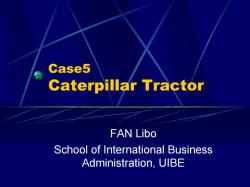
Case5 Caterpillar Tractor FAN Libo School of International Business Administration,UlBE
Case5 Caterpillar Tractor FAN Libo School of International Business Administration, UIBE

Background(1) World Earth-Moving Equipment (EME)Industry Worldwide demand for EME doubled from 1973 to 1980 The key users of EME are construction industry(60%), mining(30%)and forestry (10%).Since 1979 US construction industry faced downturn,meanwhile ME countries witnessed a massive rise in construction. Internationally EME manufacturers sold through dealers,who provided direct and after-sales service. EME industries focused more on products improvement,two-thirds of product cost was from heavy components engines,axles,transmissions and hydraulics
Background(1) World Earth-Moving Equipment (EME)Industry z Worldwide demand for EME doubled from 1973 to 1980 z The key users of EME are construction industry(60%), mining(30%) and forestry (10%). Since 1979 US construction industry faced downturn, meanwhile ME countries witnessed a massive ris e in construction. z Internationally EME manufacturers sold through dealers, who provided direct and after-sales service. z EME industries focused more on products improvement, two-thirds of product cost was from heavy components – engines, axles, transmissions and hydraulics
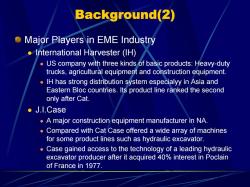
Background(2) Major Players in EME Industry International Harvester(IH) US company with three kinds of basic products:Heavy-duty trucks,agricultural equipment and construction equipment. IH has strong distribution system especialyy in Asia and Eastern Bloc countries.Its product line ranked the second only after Cat. ●J.l.Case A major construction equipment manufacturer in NA. Compared with Cat Case offered a wide array of machines for some product lines such as hydraulic excavator. ● Case gained access to the technology of a leading hydraulic excavator producer after it acquired 40%interest in Poclain of France in 1977
Background(2) Major Players in E ME Industry z International Harvester (IH) z US company with three kin ds o f basic products: Heavy-duty tru cks, agricultural equipment and con s t r u ction equip ment. z IH has strong distribution system especialyy in Asia and Easte rn Bloc cou n t ries. I ts pro d u ct line ranked the secon d only after Cat. z J.I.Case z A majo r c onstructio n eq uipme n t manufac turer in N A. z Compared with Cat Case offered a wide array of machines for some product lines such as hyd raulic excavator. z Case gained access to t h e technology o f a leading hydra ulic excavator producer after it acq uired 40% interest in Poclain of France in 1977

Background(3) e Major Players in EME Industry ●John Deere JD is a leading farm equipment manufacturer with a full product line especially in large hp tractors ● Sales of construction equipment accounts for 15%total revenue.Company's loyal dealer network was a major asset. JD aimed to be No.2 in US construction equipment market and No.4 worldwide ●Komatsu Komatsu dominated the Japanese construction equipment industry and was No.2 EME company worldwide. With the support of Japanese government and technical cooperation with other partners such as Cummins Komatsu rapidly expand its business after World War II. Outside Japan Komatsu lacked an effective dealer network especially in US market
Background(3) Major Players in E ME Industry z John Deer e z JD is a leadin g farm equip ment man ufactu r e r with a f ull pro d u ct line e specially in large hp t ract ors z Sales of con stru ction equip ment accounts for 15% t o t al revenue. Company’s loyal dealer network was a major a sset. z JD aimed to be No. 2 in US con s t r u ctio n equip ment market and No.4 worldwide. z Komatsu z Komatsu dominated the Japanese con s t r u ction equipment indust ry and was No.2 EME company worldwide. z With the support of Japanese g overnm ent and technical coo p e ration with other partners such as Cum mins Komat su rapidly expand its b usiness after World War II. z Out side Jap a n Komat su lacked a n effective dealer network especially in US market
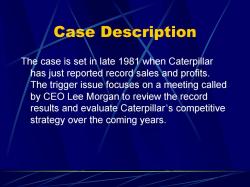
Case Description The case is set in late 1981 when Caterpillar has just reported record sales and profits. The trigger issue focuses on a meeting called by CEO Lee Morgan to review the record results and evaluate Caterpillar's competitive strategy over the coming years
Case Description The case is set in late 1981 when Caterpillar has just reported record sales and profits. The trigger issue focuses on a meeting called by CEO Lee Morgan to review the record results and evaluate Caterpillar’s competitive strategy over the coming years
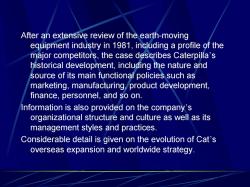
After an extensive review of the earth-moving equipment industry in 1981,including a profile of the major competitors,the case describes Caterpilla's historical development,including the nature and source of its main functional policies such as marketing,manufacturing,product development, finance,personnel,and so on. Information is also provided on the company's organizational structure and culture as well as its management styles and practices. Considerable detail is given on the evolution of Cat's overseas expansion and worldwide strategy
After an extensive review of the earth-moving equipment industry in 1981, including a profile of the major competitors, the case describes Caterpilla’s historical development, including the nature and source of its main functional policies such as marketing, manufacturing, product development, finance, personnel, and so on. Information is also provided on the company’s organizational structure and culture as well as its management styles and practices. Considerable detail is given on the evolution of Cat’s overseas expansion and worldwide strategy
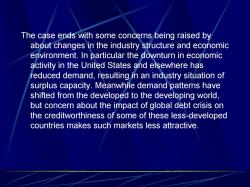
The case ends with some concerns being raised by about changes in the industry structure and economic environment.In particular the downturn in economic activity in the United States and elsewhere has reduced demand,resulting in an industry situation of surplus capacity.Meanwhile demand patterns have shifted from the developed to the developing world, but concern about the impact of global debt crisis on the creditworthiness of some of these less-developed countries makes such markets less attractive
The case ends with some concerns being raised by about changes in the industry structure and economic environment. In particular the downturn in economic activity in the United States and els ewhere has reduced demand, resulting in an industry situation of surplus capacity. Meanwhile demand patterns have shifted from the developed to the developing world, but concern about the impact of global debt crisis on the creditworthiness of some of these less-developed countries makes such markets less attractive

The case concludes with Lee Morgan ask his management to comment on what actions they think the company should take
The case concludes with Lee Morgan ask his management to comment on what actions they think the company should take
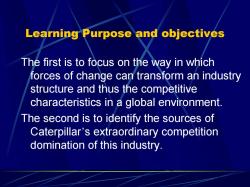
Learning Purpose and objectives The first is to focus on the way in which forces of change can transform an industry structure and thus the competitive characteristics in a global environment. The second is to identify the sources of Caterpillar's extraordinary competition domination of this industry
Learning Purpose and objectives The first is to focus on the way in which forces of change can transform an industry structure and thus the competitive characteristics in a global environment. The second is to identify the sources of Caterpillar ’s extraordinary competition domination of this industry

The third is related to the issue of strategic fit.This case provides an ideal example of a company whose strategic posture has been designed to fit external industry demands and market needs.Furthermore,this external fit is reinforced by an internal fit in which the various functional elements support the overall strategic objectives
The third is related to the issue of strategic fit. This case provides an ideal example of a company whose strategic posture has been designed to fit external industry demands and market needs. Furthermore, this external fit is reinforced by an internal fit in which the various functional elements support the overall strategic objectives
按次数下载不扣除下载券;
注册用户24小时内重复下载只扣除一次;
顺序:VIP每日次数-->可用次数-->下载券;
- 对外经贸大学:《国际企业管理 International business management》课程教学资源(案例)Case4 Canon:Competing on the capabilities.pdf
- 对外经贸大学:《国际企业管理 International business management》课程教学资源(案例)Case3:施乐和富士-施乐 ——通过战略联盟取胜.pdf
- 对外经贸大学:《国际企业管理 International business management》课程教学资源(案例)CASE 2 Lincoln Electric; Venturing Abroad.pdf
- 对外经贸大学:《国际企业管理 International business management》课程教学资源(案例)CASE 1 INGVARKAMP RAD AND IKEA.pdf
- 对外经贸大学:《国际企业管理 International business management》课程教学资源(教学大纲).pdf
- 对外经贸大学:《管理信息系统》课程教学资源(PPT授课教案)17 系统设计.ppt
- 对外经贸大学:《管理信息系统》课程教学资源(PPT授课教案)16 系统调研与系统分析报告.ppt
- 对外经贸大学:《管理信息系统》课程教学资源(PPT授课教案)15 数据库设计.ppt
- 对外经贸大学:《管理信息系统》课程教学资源(PPT授课教案)14 企业的信息管理.ppt
- 对外经贸大学:《管理信息系统》课程教学资源(PPT授课教案)13 数据资源管理.ppt
- 对外经贸大学:《管理信息系统》课程教学资源(PPT授课教案)12 管理信息系统的开发方法.ppt
- 对外经贸大学:《管理信息系统》课程教学资源(PPT授课教案)11 信息系统开发.ppt
- 对外经贸大学:《管理信息系统》课程教学资源(PPT授课教案)10 计算机网络与信息系统.ppt
- 对外经贸大学:《管理信息系统》课程教学资源(PPT授课教案)09 系统.ppt
- 对外经贸大学:《管理信息系统》课程教学资源(PPT授课教案)08 系统设计.ppt
- 对外经贸大学:《管理信息系统》课程教学资源(PPT授课教案)07 信息系统开发(系统分析).ppt
- 对外经贸大学:《管理信息系统》课程教学资源(PPT授课教案)06 信息系统开发篇(系统规划).ppt
- 对外经贸大学:《管理信息系统》课程教学资源(PPT授课教案)05 管理信息系统 Management Information System(MIS).ppt
- 对外经贸大学:《管理信息系统》课程教学资源(PPT授课教案)04 ERP的开发与应用(周庆).ppt
- 对外经贸大学:《管理信息系统》课程教学资源(PPT授课教案)03 信息与信息系统.ppt
- 对外经贸大学:《国际企业管理 International business management》课程教学资源(案例)Case6 Jollibee Foods Corporation 快乐蜂(Jollibee)快餐连锁店的国际扩张历程.pdf
- 对外经贸大学:《国际企业管理 International business management》课程教学资源(授课教案)第一篇 导论 第一章 跨国公司与跨国经营.pdf
- 对外经贸大学:《国际企业管理 International business management》课程教学资源(授课教案)第二篇 跨国经营理论 Part Two International Business Theories and Practices(第二章 基于贸易的跨国经营理论、第三章 基于外国直接投资(FDI)的跨国经营理论).pdf
- 对外经贸大学:《国际企业管理 International business management》课程教学资源(授课教案)第二篇 跨国经营理论 第三章 基于外国直接投资(FDI)的跨国经营理论.pdf
- 对外经贸大学:《国际企业管理 International business management》课程教学资源(授课教案)第四章 基于发展中国家和地区的跨国经营理论.pdf
- 对外经贸大学:《国际企业管理 International business management》课程教学资源(授课教案)第三篇 跨国进入战略 第五章 跨国进入分析.pdf
- 对外经贸大学:《国际企业管理 International business management》课程教学资源(授课教案)第三篇 跨国进入战略 第六章 跨国进入方式.pdf
- 对外经贸大学:《国际企业管理 International business management》课程教学资源(授课教案)第四篇 跨国经营战略篇 第七章 获得全球竞争优势.pdf
- 对外经贸大学:《国际企业管理 International business management》课程教学资源(授课教案)第四篇 跨国经营战略篇 第八章 跨国企业营销战略.pdf
- 对外经贸大学:《国际企业管理 International business management》课程教学资源(授课教案)第四篇 跨国经营战略篇 第九章 跨国企业的资源寻求战略.pdf
- 对外经贸大学:《国际企业管理 International business management》课程教学资源(授课教案)第五篇 走出去战略 第十章 中国企业跨国经营战略.pdf
- 对外经济贸易大学:《营销学原理》课程教学大纲 Principles of Marketing(英文).pdf
- 对外经济贸易大学:《营销学原理》课程教学资源(试题)2001-2002期末考试试卷一(英文,含答案).pdf
- 对外经济贸易大学:《营销学原理》课程教学资源(试题)1997-1998期末考试试卷二(英文,含答案).pdf
- 对外经济贸易大学:《营销学原理》课程教学资源(教学方案,英文).pdf
- 对外经贸大学:《人力资源管理 Human Resource Management》课程教学资源(作业)Chapter 1 Human Resource Management:Gaining a Competitive Advantage.pdf
- 对外经贸大学:《人力资源管理 Human Resource Management》课程教学资源(作业)Chapter 2 Strategic Human Resource Management.pdf
- 对外经贸大学:《人力资源管理 Human Resource Management》课程教学资源(作业)Chapter 3 The Analysis and Design of Work.pdf
- 对外经贸大学:《人力资源管理 Human Resource Management》课程教学资源(作业)Chapter 4 Human Resource Planning.pdf
- 对外经贸大学:《人力资源管理 Human Resource Management》课程教学资源(作业)Chapter 5 Personnel Selection and Placement.pdf
